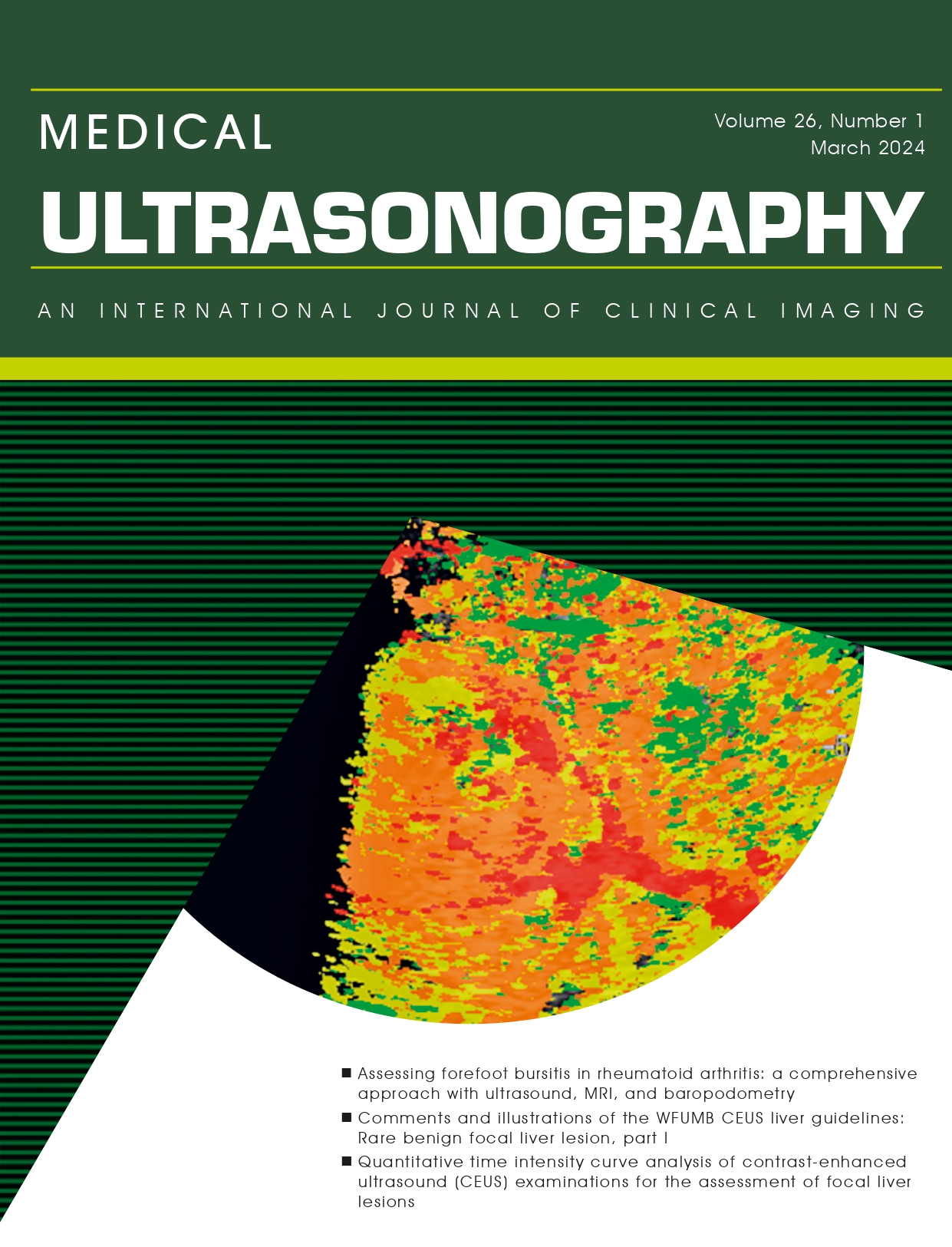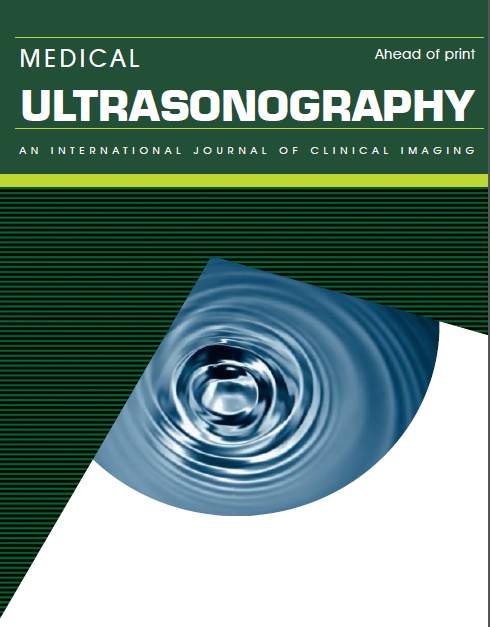Contrast-enhanced ultrasound algorithm (ACR CEUS LI-RADSv 2017)– a valuable tool for the noninvasive diagnosis of hepatocellular carcinoma in patients with chronic liver disease
Abstract
Aims: to evaluate the accuracy of LR-5 category from the latest Contrast-Enhanced Ultrasound algorithm (ACR CEUS LI-RADSv 2017) for the noninvasive diagnosis of hepatocellular carcinoma (HCC), in a real-life cohort of high-risk patients.
Material and methods: We retrospectively re-analysed the CEUS studies of 464 focal liver lesions (FLL) in 382 patients at high-risk for HCC (liver cirrhosis of any aetiology, chronic B or C hepatitis with severe fibrosis) using the ACR CEUS LI-RADSv 2017 algorithm. CEUS LI-RADS categories used for the diagnosis of HCC were: CEUS LR-5 (definitely HCC) and CEUS LR-TIV (HCC with macrovascular invasion). Contrast-enhanced CT, contrast-enhanced MRI, or histology were used as diagnostic reference methods to evaluate the CEUS LI-RADS classification of the 464 lesions.
Results: According to the reference method, the 464 lesions were classified as follows: 359 HCCs, 68 non-HCC-non-malignant lesions and 37 non-HCC malignant lesions. The diagnostic accuracy of LR-5 category for the diagnosis of hepatocellular carcinoma was 76.9%. Sensitivity, specificity, positive predictive value (PPV) and negative predictive value (NPV) were 71.9%, 94.3 %, 97.7% and 49.5%, respectively.
Conclusions: LR-5 category from ACR CEUS LI-RADSv 2017 algorithm, has good sensitivity, excellent specificity, and PPV for the diagnosis of HCC. The HCC rate increases from LR-3 to LR-5.
Keywords
References
Galle PR, Forner A, Llovet JM, et al. European Association For The Study Of The Liver. Clinical Practice Guidelines: Management of hepatocellular carcinoma. Journal of Hepatology 2018, vol. 69: 182–236.
Marrero JA, Kulik LM, Sirlin CB, et al. Diagnosis, Staging, and Management of Hepatocellular Carcinoma: 2018 Practice Guidance by the American Association for the Study of Liver Diseases. Hepatology, vol. 68, no. 2, 2018;723-750.
Friedrich-Rust M, Klopffleisch T, Nierhoff J, et al. Contrast-enhanced ultrasound for the differentiation of benign and malignant focal liver lesions: A meta-analysis. Liver Int. 2013;33:739–755.
Xie L, Guang Y, Ding H, Cai A, Huang Y. Diagnostic value of contrast-enhanced ultrasound, computed tomography and magnetic resonance imaging for focal liver lesions: a meta-analysis. Ultrasound Med Biol 2011;37:854–861.
Claudon M, Dietrich CF, Choi BI, et al. Guidelines and good clinical practice recommendations for contrast enhanced ultrasound (CEUS) in the liver—Update 2012: A WFUMB–EFSUMB initiative in cooperation with representatives of AFSUMB, AIUM, ASUM, FLAUS and ICUS. Ultraschall Med. 2013;34:11–29.
Bota S, Piscaglia F, Marinelli S, Pecorelli A, Terzi E, Bolondi L. Comparison of international guidelines for noninvasive diagnosis of hepatocellular carcinoma. Liver Cancer 2012, (3-4)1:190–200.
Schellhaas B, Hammon M, Strobel D, et al. Interobserver and intermodality agreement of standardized algorithms for non-invasive diagnosis of hepatocellular carcinoma in high-risk patients: CEUS-LI-RADS versus MRI-LI-RADS. Eur Radiol. 2018 Oct; 28(10): 4254-4264.
Quaia E. State of the Art: LI-RADS for Contrast-enhanced US. Radiology. 2019 Oct; 293(1): 4-14.
Llovet JM, Ducreux M, Lencioni R, et al. European Association For The Study Of The Liver, European Organisation For Research and Treatment of Cancer. EASL-EORTC clinical practice guidelines: management of hepatocellular carcinoma. J Hepatol 2012; 56: 908-943.
Barreiros AP, Piscaglia F, Dietrich CF. Contrast enhanced ultrasound for the diagnosis of hepatocellular carcinoma (HCC): Comments on AASLD guidelines. Journal of Hepatology 2012;57: 930–932.
Vilana R, Forner A, Bianchi L, et al. Intrahepatic peripheral cholangiocarcinoma in cirrhosis patients may display a vascular pattern similar to hepatocellular carcinoma on contrast-enhanced ultrasound. Hepatology. 2010;51:2020–2029.
Wilson SR, Lyshchik A, Piscaglia F, et al. CEUS LI-RADS: Algorithm, implementation, and key differences from CT/MRI. Abdom Radiol (NY). 2018;43:127–142.
Sporea I, Sandulescu DL, Sirli R, et al. Contrast Enhanced Ultrasound for the characterization of malignant versus benign focal liver lesion in a prospectiv multicenter experience – The SRUMB Study. L Gastrointestin Liver Dis 2019;1(28):191-196.
Strobel D, Seitz K, Blank W, et al. Contrast-enhanced Ultrasound for the Characterization of Focal Liver Lesions-Diagnostic Accuracy in Clinical Practice (DEGUM multicenter trial). Ultraschall Med 2008; 29(5):499-505.
Tranquart F, Le Gouge A, Correas JM, et al. Role of contrast-enhanced ultrasound in the blinded assessment of focal lesions in comparison with MDCT and CEMRI: Results from a multicenter clinical trial. EJC 2008: 9–15.
Terzi E, Iavarone M, Pompili M, et al. Contrast ultrasound LI-RADS LR-5 identifies hepatocellular carcinoma in cirrhosis in a multicenter retrospective study of 1,006 nodules. J Hepatol. 2018;68:485–492.
Martie A, Sporea I, Sirli R, Popescu A, Danila M. How often hepatocellular carcinoma has a typical pattern in contrast enhanced ultrasound? Maedica (Buchar). 2012; 7(3): 236–240.
Strobel D, Bernatik T, Blank W, et al. Diagnostic accuracy of CEUS in the differential diagnosis of small (= 20 mm) and subcentimetric (= 10 mm) focal liver lesions in comparison with histology. Results of the DEGUM multicenter trial. Ultraschall Med 2011; 32:593-7.
Liu W, Qin J, Guo R, et al. Accuracy of the diagnostic evaluation of hepatocellular carcinoma with LI-RADS. Acta Radiol. 2018 Feb;59(2):140-146.
van der Pol CB, Lim CS, Sirlin CB, et al. Accuracy of the Liver Imaging Reporting and Data System in Computed Tomography and Magnetic Resonance Image Analysis of Hepatocellular Carcinoma or Overall Malignancy-A Systematic Review. Gastroenterology.2019 Mar;156(4):976-986.
An C, Lee CH, Byun JH, et al. Intraindividual Comparison between Gadoxetate- Enhanced Magnetic Resonance Imaging and Dynamic Computed Tomography for Characterizing Focal Hepatic Lesions: A Multicenter, Multireader Study. Korean J Radiol. 2019 Dec;20(12):1616-1626.
DOI: http://dx.doi.org/10.11152/mu-2887
Refbacks
- There are currently no refbacks.




